Project Cost and Quality Management Planning and Control Analysis
VerifiedAdded on 2023/03/17
|17
|4237
|83
Report
AI Summary
This report delves into the critical aspects of cost and quality management within project contexts. It begins by analyzing a discussion post on quality management, evaluating various tools and techniques such as flowcharts, Pareto charts, histograms, cause and effect diagrams, checklists, and control charts. The report then transitions into a detailed cost management plan for a bungalow project, outlining processes like resource planning, cost estimation, and budgeting. It provides a breakdown of activities, resource requirements, and cost estimations across different project phases, including design, site preparation, and building. Furthermore, the report emphasizes cost control techniques, including cost of quality, expert judgment, and real-time cost tracking, and presents a comprehensive cost management plan with definitions, roles, and responsibilities, and methods for cost estimation, budgeting, and control. The report also includes a cost budgeting table and discusses cost control measures, providing a holistic view of managing project costs and ensuring quality.

Quality and Cost Management Planning
Paraphrase This Document
Need a fresh take? Get an instant paraphrase of this document with our AI Paraphraser

Table of Content
Cost Management Planning.............................................................................................................3
Process.............................................................................................................................................3
Techniques of Cost Control.............................................................................................................4
Quality Management Planning........................................................................................................4
Review Quality................................................................................................................................4
Information Management................................................................................................................5
Output Quality Control....................................................................................................................5
Bibliography....................................................................................................................................7
Cost Management Planning.............................................................................................................3
Process.............................................................................................................................................3
Techniques of Cost Control.............................................................................................................4
Quality Management Planning........................................................................................................4
Review Quality................................................................................................................................4
Information Management................................................................................................................5
Output Quality Control....................................................................................................................5
Bibliography....................................................................................................................................7
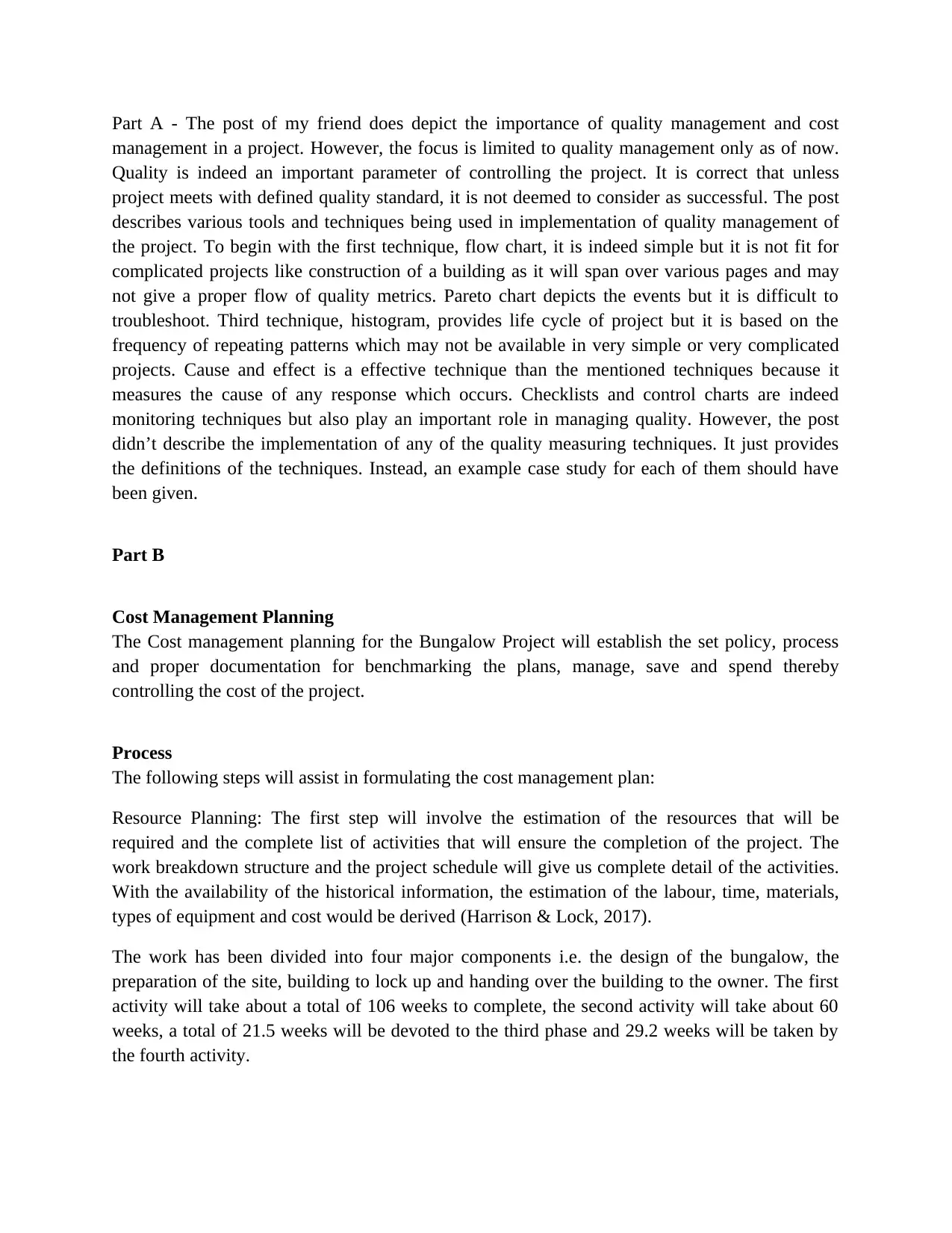
Part A - The post of my friend does depict the importance of quality management and cost
management in a project. However, the focus is limited to quality management only as of now.
Quality is indeed an important parameter of controlling the project. It is correct that unless
project meets with defined quality standard, it is not deemed to consider as successful. The post
describes various tools and techniques being used in implementation of quality management of
the project. To begin with the first technique, flow chart, it is indeed simple but it is not fit for
complicated projects like construction of a building as it will span over various pages and may
not give a proper flow of quality metrics. Pareto chart depicts the events but it is difficult to
troubleshoot. Third technique, histogram, provides life cycle of project but it is based on the
frequency of repeating patterns which may not be available in very simple or very complicated
projects. Cause and effect is a effective technique than the mentioned techniques because it
measures the cause of any response which occurs. Checklists and control charts are indeed
monitoring techniques but also play an important role in managing quality. However, the post
didn’t describe the implementation of any of the quality measuring techniques. It just provides
the definitions of the techniques. Instead, an example case study for each of them should have
been given.
Part B
Cost Management Planning
The Cost management planning for the Bungalow Project will establish the set policy, process
and proper documentation for benchmarking the plans, manage, save and spend thereby
controlling the cost of the project.
Process
The following steps will assist in formulating the cost management plan:
Resource Planning: The first step will involve the estimation of the resources that will be
required and the complete list of activities that will ensure the completion of the project. The
work breakdown structure and the project schedule will give us complete detail of the activities.
With the availability of the historical information, the estimation of the labour, time, materials,
types of equipment and cost would be derived (Harrison & Lock, 2017).
The work has been divided into four major components i.e. the design of the bungalow, the
preparation of the site, building to lock up and handing over the building to the owner. The first
activity will take about a total of 106 weeks to complete, the second activity will take about 60
weeks, a total of 21.5 weeks will be devoted to the third phase and 29.2 weeks will be taken by
the fourth activity.
management in a project. However, the focus is limited to quality management only as of now.
Quality is indeed an important parameter of controlling the project. It is correct that unless
project meets with defined quality standard, it is not deemed to consider as successful. The post
describes various tools and techniques being used in implementation of quality management of
the project. To begin with the first technique, flow chart, it is indeed simple but it is not fit for
complicated projects like construction of a building as it will span over various pages and may
not give a proper flow of quality metrics. Pareto chart depicts the events but it is difficult to
troubleshoot. Third technique, histogram, provides life cycle of project but it is based on the
frequency of repeating patterns which may not be available in very simple or very complicated
projects. Cause and effect is a effective technique than the mentioned techniques because it
measures the cause of any response which occurs. Checklists and control charts are indeed
monitoring techniques but also play an important role in managing quality. However, the post
didn’t describe the implementation of any of the quality measuring techniques. It just provides
the definitions of the techniques. Instead, an example case study for each of them should have
been given.
Part B
Cost Management Planning
The Cost management planning for the Bungalow Project will establish the set policy, process
and proper documentation for benchmarking the plans, manage, save and spend thereby
controlling the cost of the project.
Process
The following steps will assist in formulating the cost management plan:
Resource Planning: The first step will involve the estimation of the resources that will be
required and the complete list of activities that will ensure the completion of the project. The
work breakdown structure and the project schedule will give us complete detail of the activities.
With the availability of the historical information, the estimation of the labour, time, materials,
types of equipment and cost would be derived (Harrison & Lock, 2017).
The work has been divided into four major components i.e. the design of the bungalow, the
preparation of the site, building to lock up and handing over the building to the owner. The first
activity will take about a total of 106 weeks to complete, the second activity will take about 60
weeks, a total of 21.5 weeks will be devoted to the third phase and 29.2 weeks will be taken by
the fourth activity.
⊘ This is a preview!⊘
Do you want full access?
Subscribe today to unlock all pages.

Trusted by 1+ million students worldwide
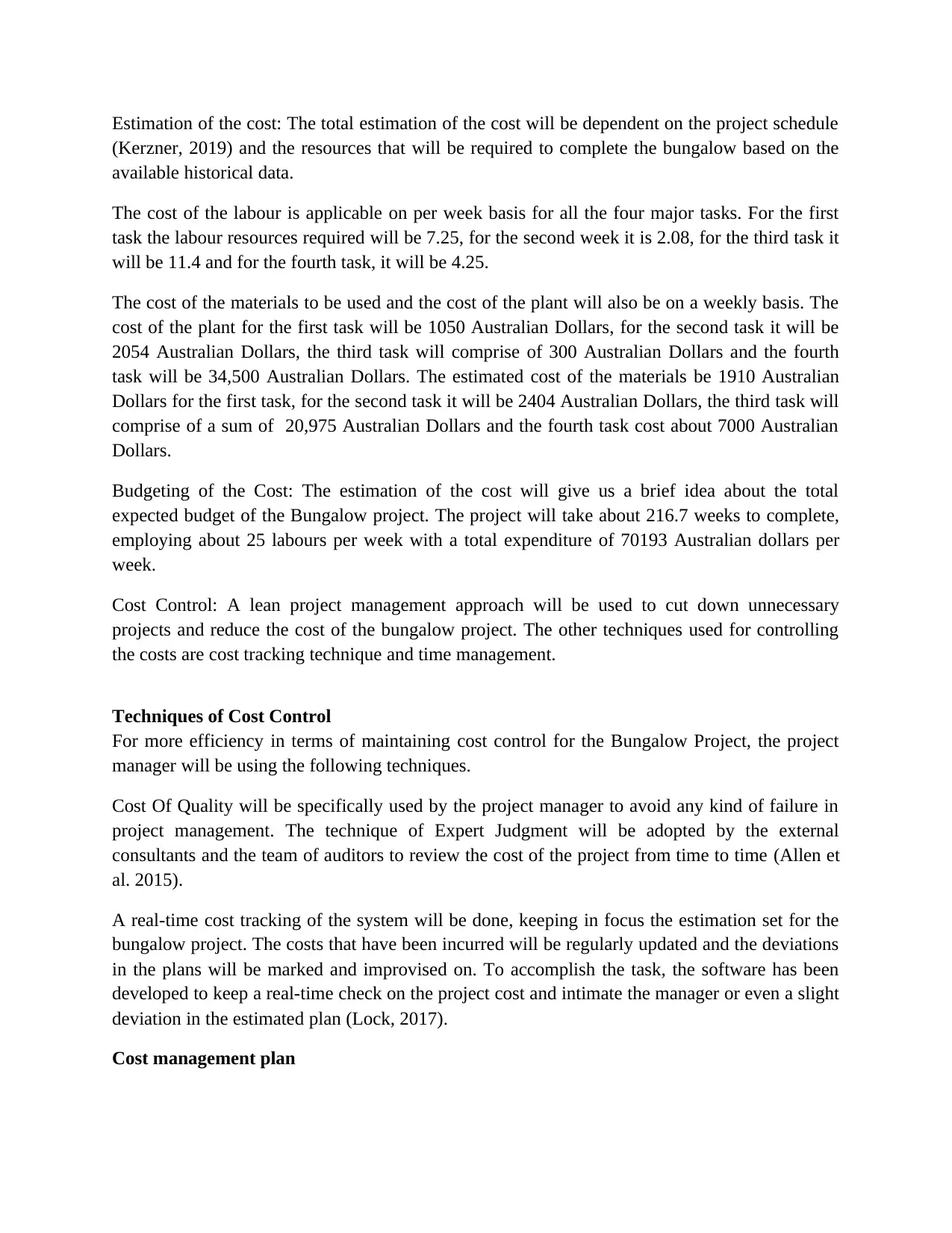
Estimation of the cost: The total estimation of the cost will be dependent on the project schedule
(Kerzner, 2019) and the resources that will be required to complete the bungalow based on the
available historical data.
The cost of the labour is applicable on per week basis for all the four major tasks. For the first
task the labour resources required will be 7.25, for the second week it is 2.08, for the third task it
will be 11.4 and for the fourth task, it will be 4.25.
The cost of the materials to be used and the cost of the plant will also be on a weekly basis. The
cost of the plant for the first task will be 1050 Australian Dollars, for the second task it will be
2054 Australian Dollars, the third task will comprise of 300 Australian Dollars and the fourth
task will be 34,500 Australian Dollars. The estimated cost of the materials be 1910 Australian
Dollars for the first task, for the second task it will be 2404 Australian Dollars, the third task will
comprise of a sum of 20,975 Australian Dollars and the fourth task cost about 7000 Australian
Dollars.
Budgeting of the Cost: The estimation of the cost will give us a brief idea about the total
expected budget of the Bungalow project. The project will take about 216.7 weeks to complete,
employing about 25 labours per week with a total expenditure of 70193 Australian dollars per
week.
Cost Control: A lean project management approach will be used to cut down unnecessary
projects and reduce the cost of the bungalow project. The other techniques used for controlling
the costs are cost tracking technique and time management.
Techniques of Cost Control
For more efficiency in terms of maintaining cost control for the Bungalow Project, the project
manager will be using the following techniques.
Cost Of Quality will be specifically used by the project manager to avoid any kind of failure in
project management. The technique of Expert Judgment will be adopted by the external
consultants and the team of auditors to review the cost of the project from time to time (Allen et
al. 2015).
A real-time cost tracking of the system will be done, keeping in focus the estimation set for the
bungalow project. The costs that have been incurred will be regularly updated and the deviations
in the plans will be marked and improvised on. To accomplish the task, the software has been
developed to keep a real-time check on the project cost and intimate the manager or even a slight
deviation in the estimated plan (Lock, 2017).
Cost management plan
(Kerzner, 2019) and the resources that will be required to complete the bungalow based on the
available historical data.
The cost of the labour is applicable on per week basis for all the four major tasks. For the first
task the labour resources required will be 7.25, for the second week it is 2.08, for the third task it
will be 11.4 and for the fourth task, it will be 4.25.
The cost of the materials to be used and the cost of the plant will also be on a weekly basis. The
cost of the plant for the first task will be 1050 Australian Dollars, for the second task it will be
2054 Australian Dollars, the third task will comprise of 300 Australian Dollars and the fourth
task will be 34,500 Australian Dollars. The estimated cost of the materials be 1910 Australian
Dollars for the first task, for the second task it will be 2404 Australian Dollars, the third task will
comprise of a sum of 20,975 Australian Dollars and the fourth task cost about 7000 Australian
Dollars.
Budgeting of the Cost: The estimation of the cost will give us a brief idea about the total
expected budget of the Bungalow project. The project will take about 216.7 weeks to complete,
employing about 25 labours per week with a total expenditure of 70193 Australian dollars per
week.
Cost Control: A lean project management approach will be used to cut down unnecessary
projects and reduce the cost of the bungalow project. The other techniques used for controlling
the costs are cost tracking technique and time management.
Techniques of Cost Control
For more efficiency in terms of maintaining cost control for the Bungalow Project, the project
manager will be using the following techniques.
Cost Of Quality will be specifically used by the project manager to avoid any kind of failure in
project management. The technique of Expert Judgment will be adopted by the external
consultants and the team of auditors to review the cost of the project from time to time (Allen et
al. 2015).
A real-time cost tracking of the system will be done, keeping in focus the estimation set for the
bungalow project. The costs that have been incurred will be regularly updated and the deviations
in the plans will be marked and improvised on. To accomplish the task, the software has been
developed to keep a real-time check on the project cost and intimate the manager or even a slight
deviation in the estimated plan (Lock, 2017).
Cost management plan
Paraphrase This Document
Need a fresh take? Get an instant paraphrase of this document with our AI Paraphraser
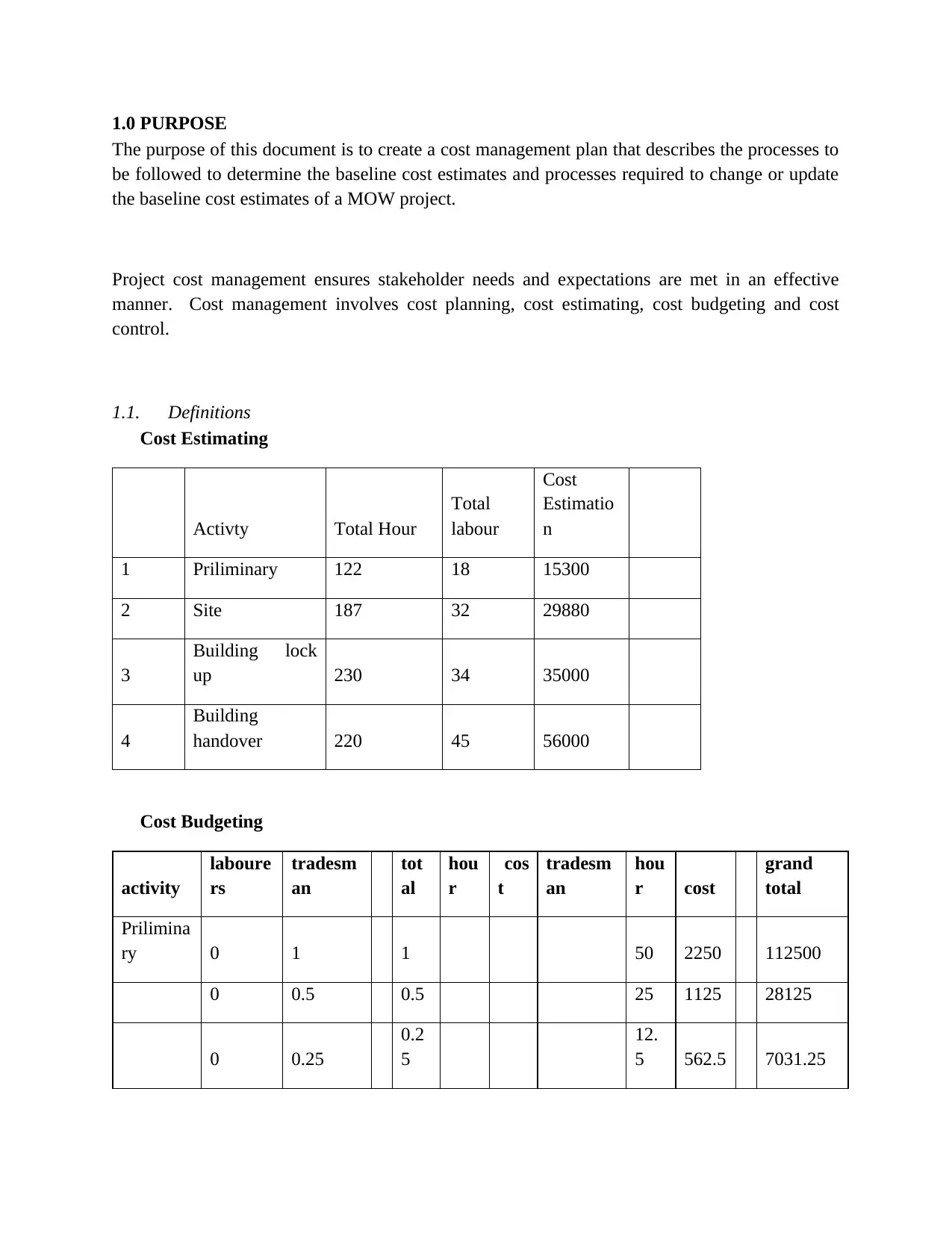
1.0 PURPOSE
The purpose of this document is to create a cost management plan that describes the processes to
be followed to determine the baseline cost estimates and processes required to change or update
the baseline cost estimates of a MOW project.
Project cost management ensures stakeholder needs and expectations are met in an effective
manner. Cost management involves cost planning, cost estimating, cost budgeting and cost
control.
1.1. Definitions
Cost Estimating
Activty Total Hour
Total
labour
Cost
Estimatio
n
1 Priliminary 122 18 15300
2 Site 187 32 29880
3
Building lock
up 230 34 35000
4
Building
handover 220 45 56000
Cost Budgeting
activity
laboure
rs
tradesm
an
tot
al
hou
r
cos
t
tradesm
an
hou
r cost
grand
total
Prilimina
ry 0 1 1 50 2250 112500
0 0.5 0.5 25 1125 28125
0 0.25
0.2
5
12.
5 562.5 7031.25
The purpose of this document is to create a cost management plan that describes the processes to
be followed to determine the baseline cost estimates and processes required to change or update
the baseline cost estimates of a MOW project.
Project cost management ensures stakeholder needs and expectations are met in an effective
manner. Cost management involves cost planning, cost estimating, cost budgeting and cost
control.
1.1. Definitions
Cost Estimating
Activty Total Hour
Total
labour
Cost
Estimatio
n
1 Priliminary 122 18 15300
2 Site 187 32 29880
3
Building lock
up 230 34 35000
4
Building
handover 220 45 56000
Cost Budgeting
activity
laboure
rs
tradesm
an
tot
al
hou
r
cos
t
tradesm
an
hou
r cost
grand
total
Prilimina
ry 0 1 1 50 2250 112500
0 0.5 0.5 25 1125 28125
0 0.25
0.2
5
12.
5 562.5 7031.25
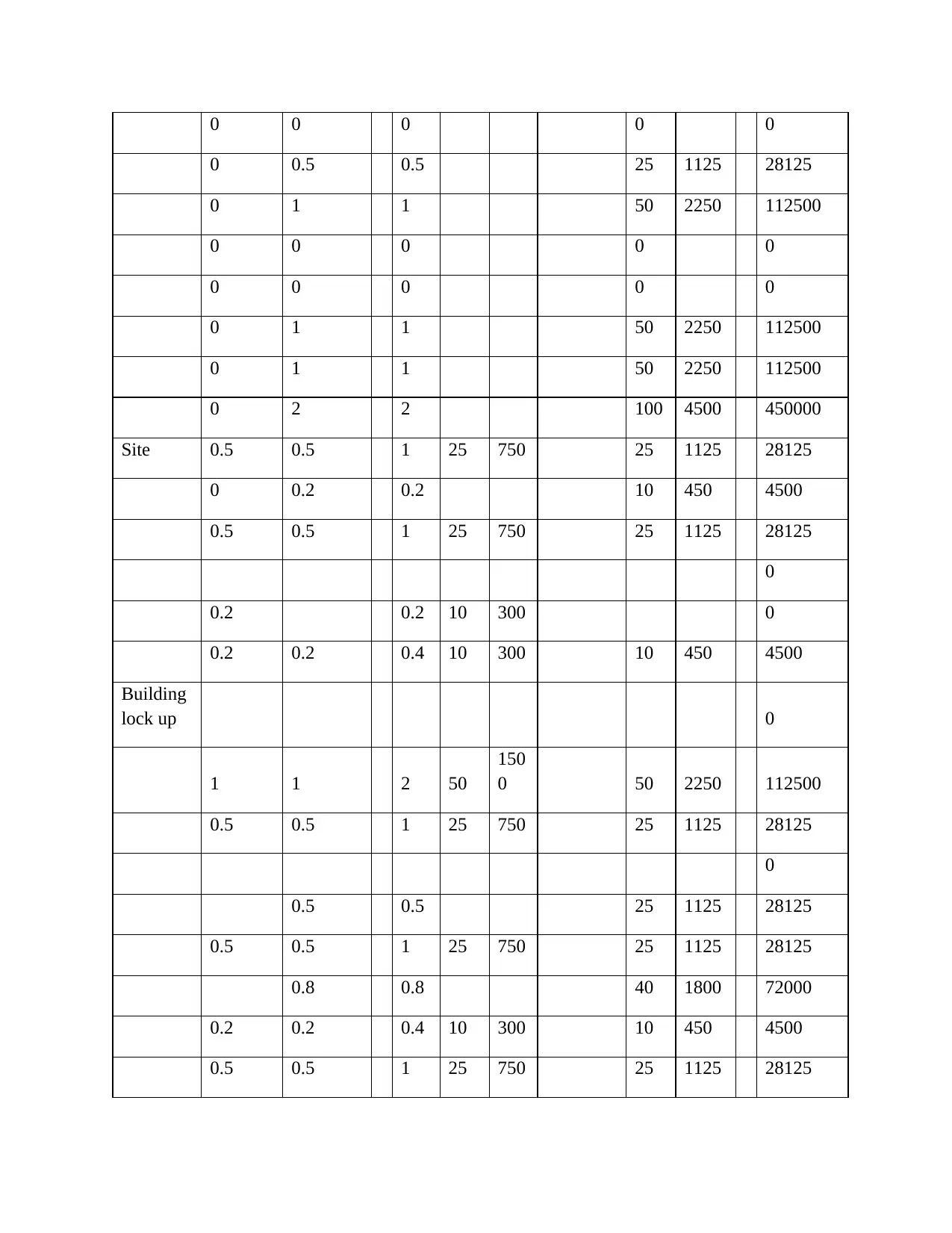
0 0 0 0 0
0 0.5 0.5 25 1125 28125
0 1 1 50 2250 112500
0 0 0 0 0
0 0 0 0 0
0 1 1 50 2250 112500
0 1 1 50 2250 112500
0 2 2 100 4500 450000
Site 0.5 0.5 1 25 750 25 1125 28125
0 0.2 0.2 10 450 4500
0.5 0.5 1 25 750 25 1125 28125
0
0.2 0.2 10 300 0
0.2 0.2 0.4 10 300 10 450 4500
Building
lock up 0
1 1 2 50
150
0 50 2250 112500
0.5 0.5 1 25 750 25 1125 28125
0
0.5 0.5 25 1125 28125
0.5 0.5 1 25 750 25 1125 28125
0.8 0.8 40 1800 72000
0.2 0.2 0.4 10 300 10 450 4500
0.5 0.5 1 25 750 25 1125 28125
0 0.5 0.5 25 1125 28125
0 1 1 50 2250 112500
0 0 0 0 0
0 0 0 0 0
0 1 1 50 2250 112500
0 1 1 50 2250 112500
0 2 2 100 4500 450000
Site 0.5 0.5 1 25 750 25 1125 28125
0 0.2 0.2 10 450 4500
0.5 0.5 1 25 750 25 1125 28125
0
0.2 0.2 10 300 0
0.2 0.2 0.4 10 300 10 450 4500
Building
lock up 0
1 1 2 50
150
0 50 2250 112500
0.5 0.5 1 25 750 25 1125 28125
0
0.5 0.5 25 1125 28125
0.5 0.5 1 25 750 25 1125 28125
0.8 0.8 40 1800 72000
0.2 0.2 0.4 10 300 10 450 4500
0.5 0.5 1 25 750 25 1125 28125
⊘ This is a preview!⊘
Do you want full access?
Subscribe today to unlock all pages.

Trusted by 1+ million students worldwide
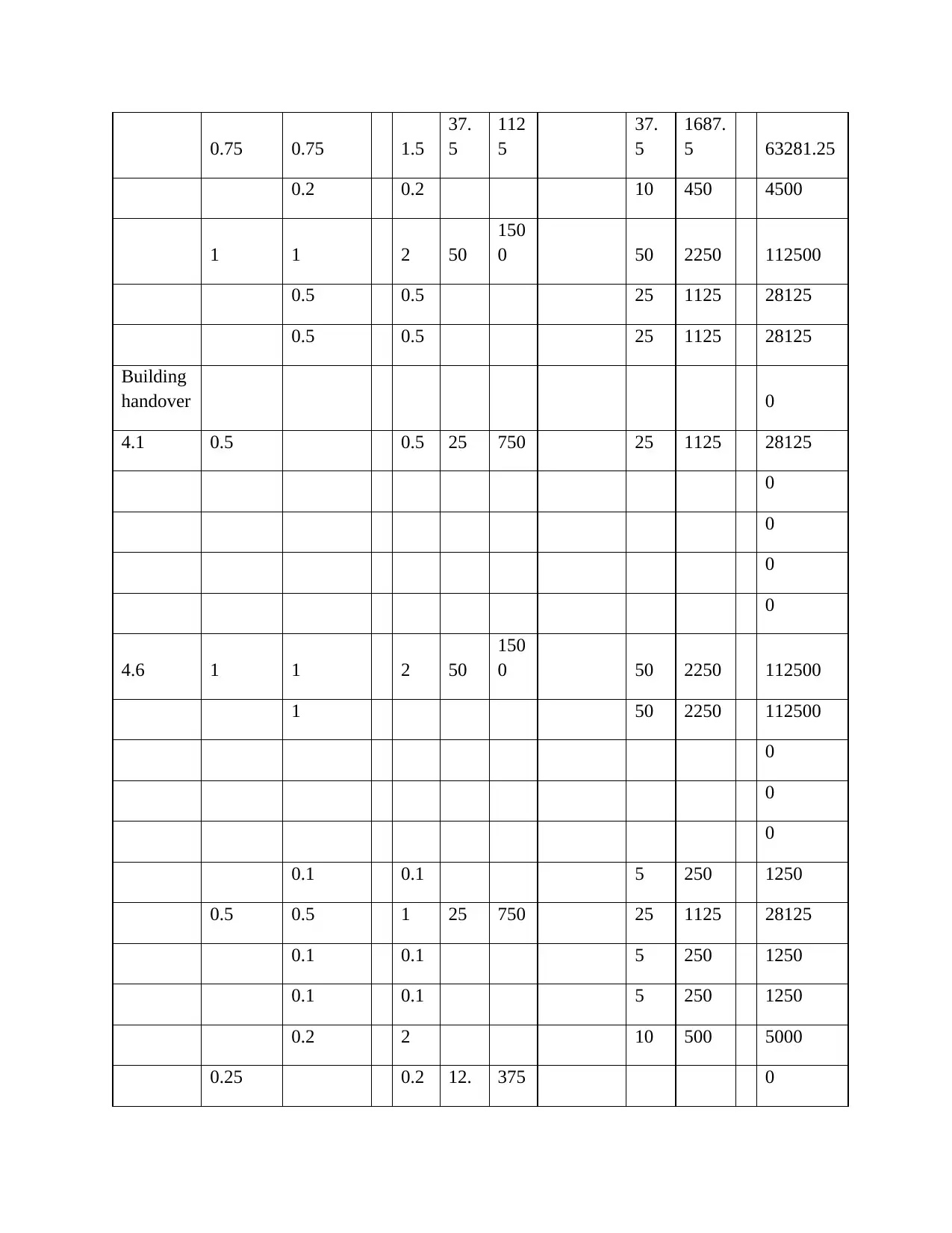
0.75 0.75 1.5
37.
5
112
5
37.
5
1687.
5 63281.25
0.2 0.2 10 450 4500
1 1 2 50
150
0 50 2250 112500
0.5 0.5 25 1125 28125
0.5 0.5 25 1125 28125
Building
handover 0
4.1 0.5 0.5 25 750 25 1125 28125
0
0
0
0
4.6 1 1 2 50
150
0 50 2250 112500
1 50 2250 112500
0
0
0
0.1 0.1 5 250 1250
0.5 0.5 1 25 750 25 1125 28125
0.1 0.1 5 250 1250
0.1 0.1 5 250 1250
0.2 2 10 500 5000
0.25 0.2 12. 375 0
37.
5
112
5
37.
5
1687.
5 63281.25
0.2 0.2 10 450 4500
1 1 2 50
150
0 50 2250 112500
0.5 0.5 25 1125 28125
0.5 0.5 25 1125 28125
Building
handover 0
4.1 0.5 0.5 25 750 25 1125 28125
0
0
0
0
4.6 1 1 2 50
150
0 50 2250 112500
1 50 2250 112500
0
0
0
0.1 0.1 5 250 1250
0.5 0.5 1 25 750 25 1125 28125
0.1 0.1 5 250 1250
0.1 0.1 5 250 1250
0.2 2 10 500 5000
0.25 0.2 12. 375 0
Paraphrase This Document
Need a fresh take? Get an instant paraphrase of this document with our AI Paraphraser
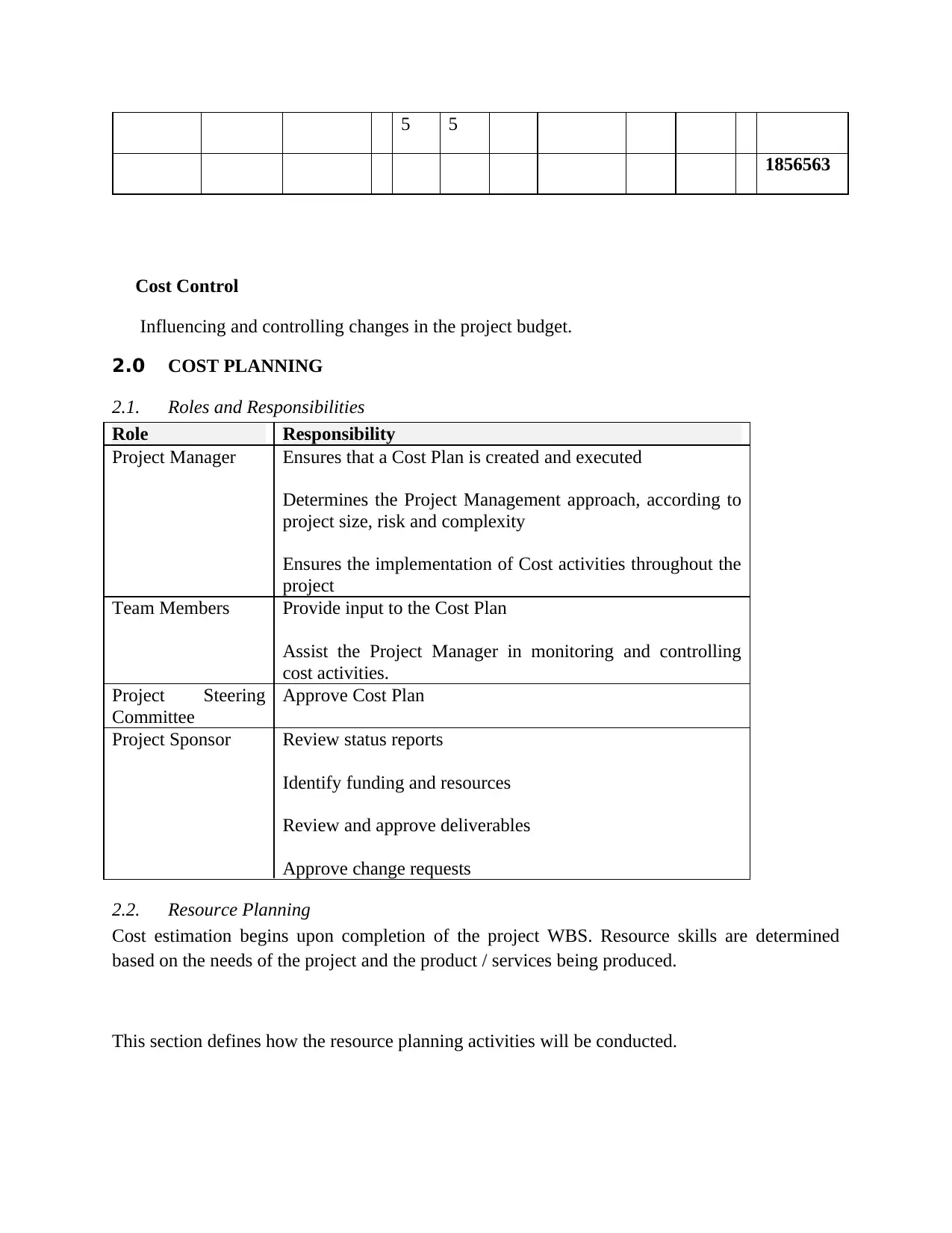
5 5
1856563
Cost Control
Influencing and controlling changes in the project budget.
2.0 COST PLANNING
2.1. Roles and Responsibilities
Role Responsibility
Project Manager Ensures that a Cost Plan is created and executed
Determines the Project Management approach, according to
project size, risk and complexity
Ensures the implementation of Cost activities throughout the
project
Team Members Provide input to the Cost Plan
Assist the Project Manager in monitoring and controlling
cost activities.
Project Steering
Committee
Approve Cost Plan
Project Sponsor Review status reports
Identify funding and resources
Review and approve deliverables
Approve change requests
2.2. Resource Planning
Cost estimation begins upon completion of the project WBS. Resource skills are determined
based on the needs of the project and the product / services being produced.
This section defines how the resource planning activities will be conducted.
1856563
Cost Control
Influencing and controlling changes in the project budget.
2.0 COST PLANNING
2.1. Roles and Responsibilities
Role Responsibility
Project Manager Ensures that a Cost Plan is created and executed
Determines the Project Management approach, according to
project size, risk and complexity
Ensures the implementation of Cost activities throughout the
project
Team Members Provide input to the Cost Plan
Assist the Project Manager in monitoring and controlling
cost activities.
Project Steering
Committee
Approve Cost Plan
Project Sponsor Review status reports
Identify funding and resources
Review and approve deliverables
Approve change requests
2.2. Resource Planning
Cost estimation begins upon completion of the project WBS. Resource skills are determined
based on the needs of the project and the product / services being produced.
This section defines how the resource planning activities will be conducted.
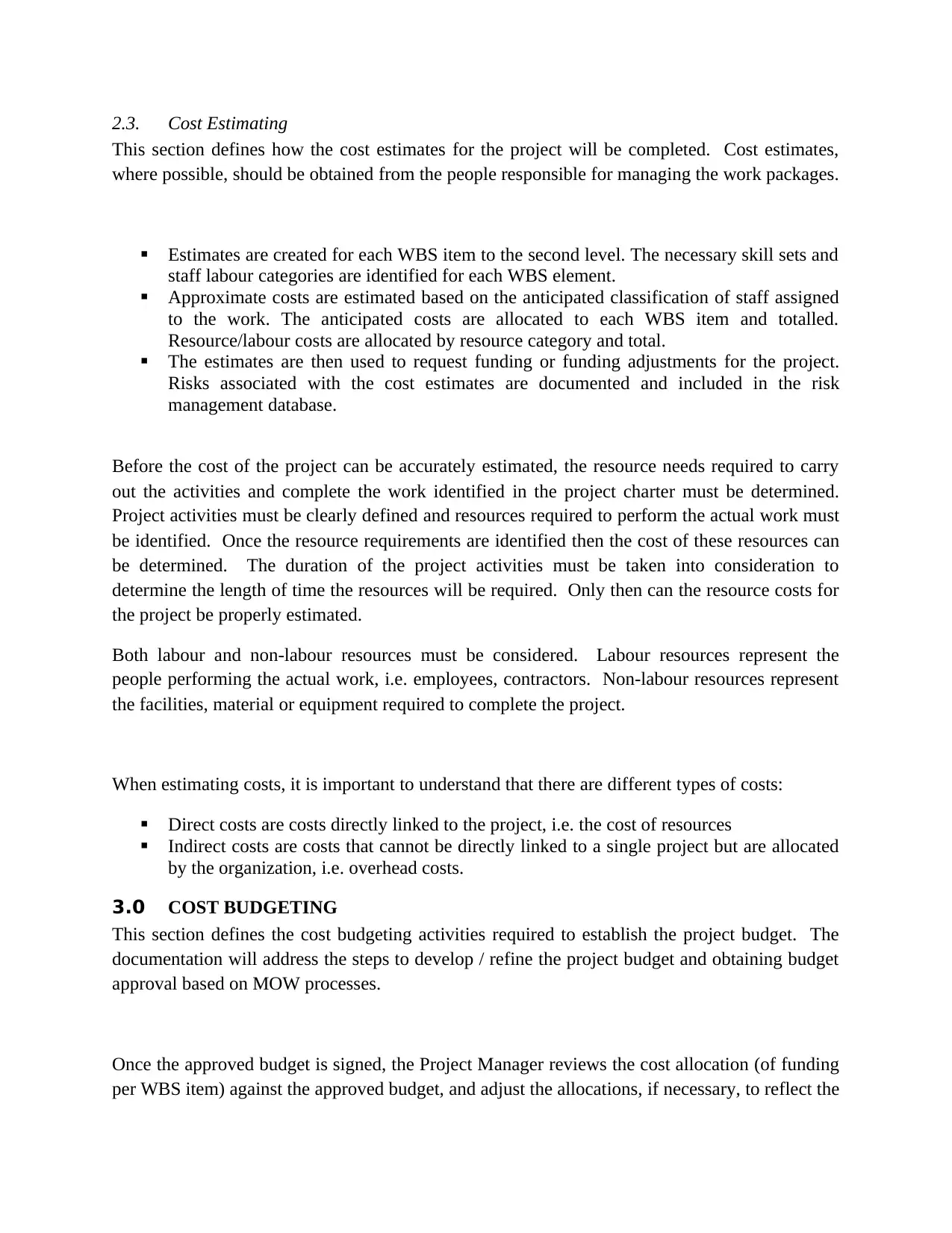
2.3. Cost Estimating
This section defines how the cost estimates for the project will be completed. Cost estimates,
where possible, should be obtained from the people responsible for managing the work packages.
Estimates are created for each WBS item to the second level. The necessary skill sets and
staff labour categories are identified for each WBS element.
Approximate costs are estimated based on the anticipated classification of staff assigned
to the work. The anticipated costs are allocated to each WBS item and totalled.
Resource/labour costs are allocated by resource category and total.
The estimates are then used to request funding or funding adjustments for the project.
Risks associated with the cost estimates are documented and included in the risk
management database.
Before the cost of the project can be accurately estimated, the resource needs required to carry
out the activities and complete the work identified in the project charter must be determined.
Project activities must be clearly defined and resources required to perform the actual work must
be identified. Once the resource requirements are identified then the cost of these resources can
be determined. The duration of the project activities must be taken into consideration to
determine the length of time the resources will be required. Only then can the resource costs for
the project be properly estimated.
Both labour and non-labour resources must be considered. Labour resources represent the
people performing the actual work, i.e. employees, contractors. Non-labour resources represent
the facilities, material or equipment required to complete the project.
When estimating costs, it is important to understand that there are different types of costs:
Direct costs are costs directly linked to the project, i.e. the cost of resources
Indirect costs are costs that cannot be directly linked to a single project but are allocated
by the organization, i.e. overhead costs.
3.0 COST BUDGETING
This section defines the cost budgeting activities required to establish the project budget. The
documentation will address the steps to develop / refine the project budget and obtaining budget
approval based on MOW processes.
Once the approved budget is signed, the Project Manager reviews the cost allocation (of funding
per WBS item) against the approved budget, and adjust the allocations, if necessary, to reflect the
This section defines how the cost estimates for the project will be completed. Cost estimates,
where possible, should be obtained from the people responsible for managing the work packages.
Estimates are created for each WBS item to the second level. The necessary skill sets and
staff labour categories are identified for each WBS element.
Approximate costs are estimated based on the anticipated classification of staff assigned
to the work. The anticipated costs are allocated to each WBS item and totalled.
Resource/labour costs are allocated by resource category and total.
The estimates are then used to request funding or funding adjustments for the project.
Risks associated with the cost estimates are documented and included in the risk
management database.
Before the cost of the project can be accurately estimated, the resource needs required to carry
out the activities and complete the work identified in the project charter must be determined.
Project activities must be clearly defined and resources required to perform the actual work must
be identified. Once the resource requirements are identified then the cost of these resources can
be determined. The duration of the project activities must be taken into consideration to
determine the length of time the resources will be required. Only then can the resource costs for
the project be properly estimated.
Both labour and non-labour resources must be considered. Labour resources represent the
people performing the actual work, i.e. employees, contractors. Non-labour resources represent
the facilities, material or equipment required to complete the project.
When estimating costs, it is important to understand that there are different types of costs:
Direct costs are costs directly linked to the project, i.e. the cost of resources
Indirect costs are costs that cannot be directly linked to a single project but are allocated
by the organization, i.e. overhead costs.
3.0 COST BUDGETING
This section defines the cost budgeting activities required to establish the project budget. The
documentation will address the steps to develop / refine the project budget and obtaining budget
approval based on MOW processes.
Once the approved budget is signed, the Project Manager reviews the cost allocation (of funding
per WBS item) against the approved budget, and adjust the allocations, if necessary, to reflect the
⊘ This is a preview!⊘
Do you want full access?
Subscribe today to unlock all pages.

Trusted by 1+ million students worldwide
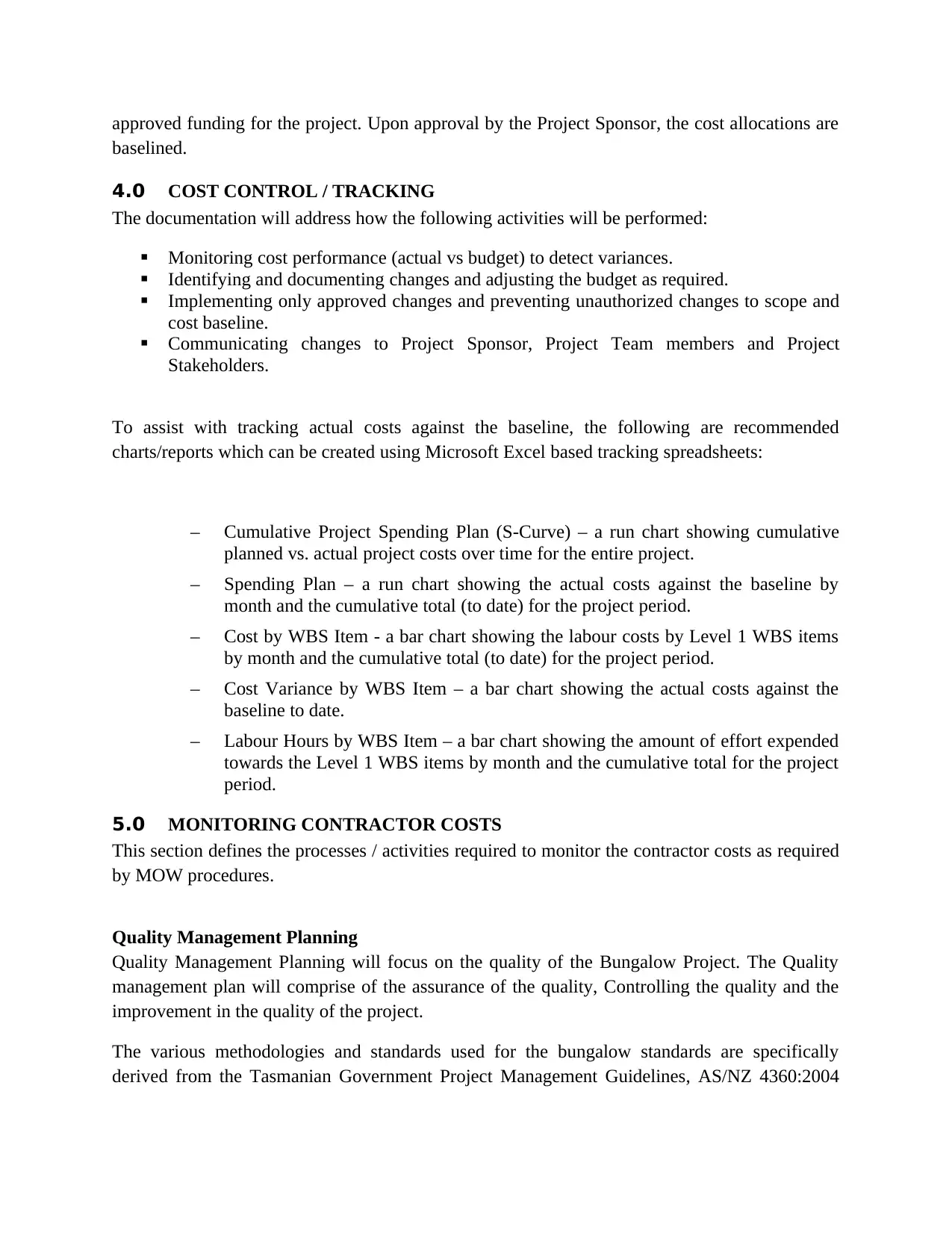
approved funding for the project. Upon approval by the Project Sponsor, the cost allocations are
baselined.
4.0 COST CONTROL / TRACKING
The documentation will address how the following activities will be performed:
Monitoring cost performance (actual vs budget) to detect variances.
Identifying and documenting changes and adjusting the budget as required.
Implementing only approved changes and preventing unauthorized changes to scope and
cost baseline.
Communicating changes to Project Sponsor, Project Team members and Project
Stakeholders.
To assist with tracking actual costs against the baseline, the following are recommended
charts/reports which can be created using Microsoft Excel based tracking spreadsheets:
– Cumulative Project Spending Plan (S-Curve) – a run chart showing cumulative
planned vs. actual project costs over time for the entire project.
– Spending Plan – a run chart showing the actual costs against the baseline by
month and the cumulative total (to date) for the project period.
– Cost by WBS Item - a bar chart showing the labour costs by Level 1 WBS items
by month and the cumulative total (to date) for the project period.
– Cost Variance by WBS Item – a bar chart showing the actual costs against the
baseline to date.
– Labour Hours by WBS Item – a bar chart showing the amount of effort expended
towards the Level 1 WBS items by month and the cumulative total for the project
period.
5.0 MONITORING CONTRACTOR COSTS
This section defines the processes / activities required to monitor the contractor costs as required
by MOW procedures.
Quality Management Planning
Quality Management Planning will focus on the quality of the Bungalow Project. The Quality
management plan will comprise of the assurance of the quality, Controlling the quality and the
improvement in the quality of the project.
The various methodologies and standards used for the bungalow standards are specifically
derived from the Tasmanian Government Project Management Guidelines, AS/NZ 4360:2004
baselined.
4.0 COST CONTROL / TRACKING
The documentation will address how the following activities will be performed:
Monitoring cost performance (actual vs budget) to detect variances.
Identifying and documenting changes and adjusting the budget as required.
Implementing only approved changes and preventing unauthorized changes to scope and
cost baseline.
Communicating changes to Project Sponsor, Project Team members and Project
Stakeholders.
To assist with tracking actual costs against the baseline, the following are recommended
charts/reports which can be created using Microsoft Excel based tracking spreadsheets:
– Cumulative Project Spending Plan (S-Curve) – a run chart showing cumulative
planned vs. actual project costs over time for the entire project.
– Spending Plan – a run chart showing the actual costs against the baseline by
month and the cumulative total (to date) for the project period.
– Cost by WBS Item - a bar chart showing the labour costs by Level 1 WBS items
by month and the cumulative total (to date) for the project period.
– Cost Variance by WBS Item – a bar chart showing the actual costs against the
baseline to date.
– Labour Hours by WBS Item – a bar chart showing the amount of effort expended
towards the Level 1 WBS items by month and the cumulative total for the project
period.
5.0 MONITORING CONTRACTOR COSTS
This section defines the processes / activities required to monitor the contractor costs as required
by MOW procedures.
Quality Management Planning
Quality Management Planning will focus on the quality of the Bungalow Project. The Quality
management plan will comprise of the assurance of the quality, Controlling the quality and the
improvement in the quality of the project.
The various methodologies and standards used for the bungalow standards are specifically
derived from the Tasmanian Government Project Management Guidelines, AS/NZ 4360:2004
Paraphrase This Document
Need a fresh take? Get an instant paraphrase of this document with our AI Paraphraser
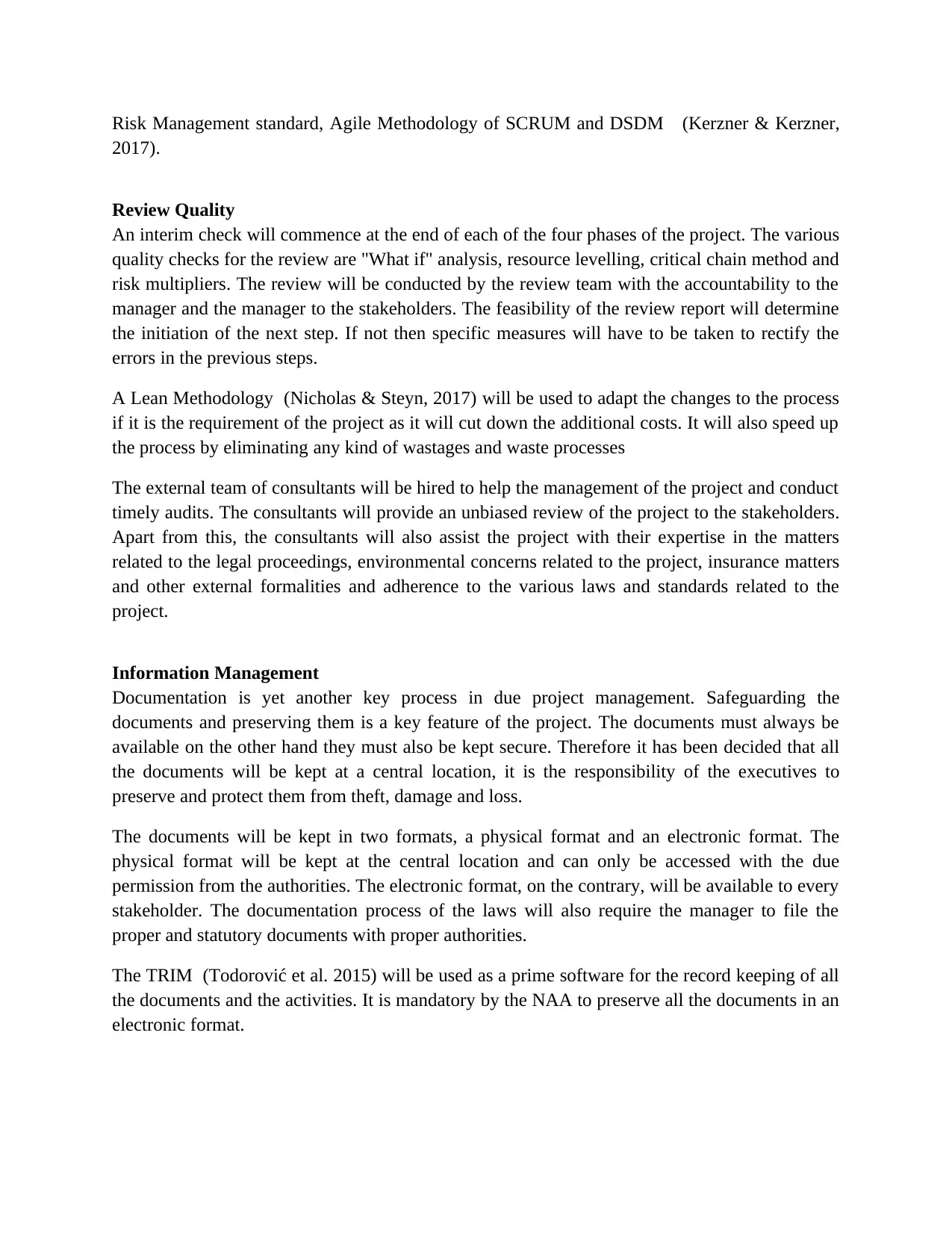
Risk Management standard, Agile Methodology of SCRUM and DSDM (Kerzner & Kerzner,
2017).
Review Quality
An interim check will commence at the end of each of the four phases of the project. The various
quality checks for the review are "What if" analysis, resource levelling, critical chain method and
risk multipliers. The review will be conducted by the review team with the accountability to the
manager and the manager to the stakeholders. The feasibility of the review report will determine
the initiation of the next step. If not then specific measures will have to be taken to rectify the
errors in the previous steps.
A Lean Methodology (Nicholas & Steyn, 2017) will be used to adapt the changes to the process
if it is the requirement of the project as it will cut down the additional costs. It will also speed up
the process by eliminating any kind of wastages and waste processes
The external team of consultants will be hired to help the management of the project and conduct
timely audits. The consultants will provide an unbiased review of the project to the stakeholders.
Apart from this, the consultants will also assist the project with their expertise in the matters
related to the legal proceedings, environmental concerns related to the project, insurance matters
and other external formalities and adherence to the various laws and standards related to the
project.
Information Management
Documentation is yet another key process in due project management. Safeguarding the
documents and preserving them is a key feature of the project. The documents must always be
available on the other hand they must also be kept secure. Therefore it has been decided that all
the documents will be kept at a central location, it is the responsibility of the executives to
preserve and protect them from theft, damage and loss.
The documents will be kept in two formats, a physical format and an electronic format. The
physical format will be kept at the central location and can only be accessed with the due
permission from the authorities. The electronic format, on the contrary, will be available to every
stakeholder. The documentation process of the laws will also require the manager to file the
proper and statutory documents with proper authorities.
The TRIM (Todorović et al. 2015) will be used as a prime software for the record keeping of all
the documents and the activities. It is mandatory by the NAA to preserve all the documents in an
electronic format.
2017).
Review Quality
An interim check will commence at the end of each of the four phases of the project. The various
quality checks for the review are "What if" analysis, resource levelling, critical chain method and
risk multipliers. The review will be conducted by the review team with the accountability to the
manager and the manager to the stakeholders. The feasibility of the review report will determine
the initiation of the next step. If not then specific measures will have to be taken to rectify the
errors in the previous steps.
A Lean Methodology (Nicholas & Steyn, 2017) will be used to adapt the changes to the process
if it is the requirement of the project as it will cut down the additional costs. It will also speed up
the process by eliminating any kind of wastages and waste processes
The external team of consultants will be hired to help the management of the project and conduct
timely audits. The consultants will provide an unbiased review of the project to the stakeholders.
Apart from this, the consultants will also assist the project with their expertise in the matters
related to the legal proceedings, environmental concerns related to the project, insurance matters
and other external formalities and adherence to the various laws and standards related to the
project.
Information Management
Documentation is yet another key process in due project management. Safeguarding the
documents and preserving them is a key feature of the project. The documents must always be
available on the other hand they must also be kept secure. Therefore it has been decided that all
the documents will be kept at a central location, it is the responsibility of the executives to
preserve and protect them from theft, damage and loss.
The documents will be kept in two formats, a physical format and an electronic format. The
physical format will be kept at the central location and can only be accessed with the due
permission from the authorities. The electronic format, on the contrary, will be available to every
stakeholder. The documentation process of the laws will also require the manager to file the
proper and statutory documents with proper authorities.
The TRIM (Todorović et al. 2015) will be used as a prime software for the record keeping of all
the documents and the activities. It is mandatory by the NAA to preserve all the documents in an
electronic format.
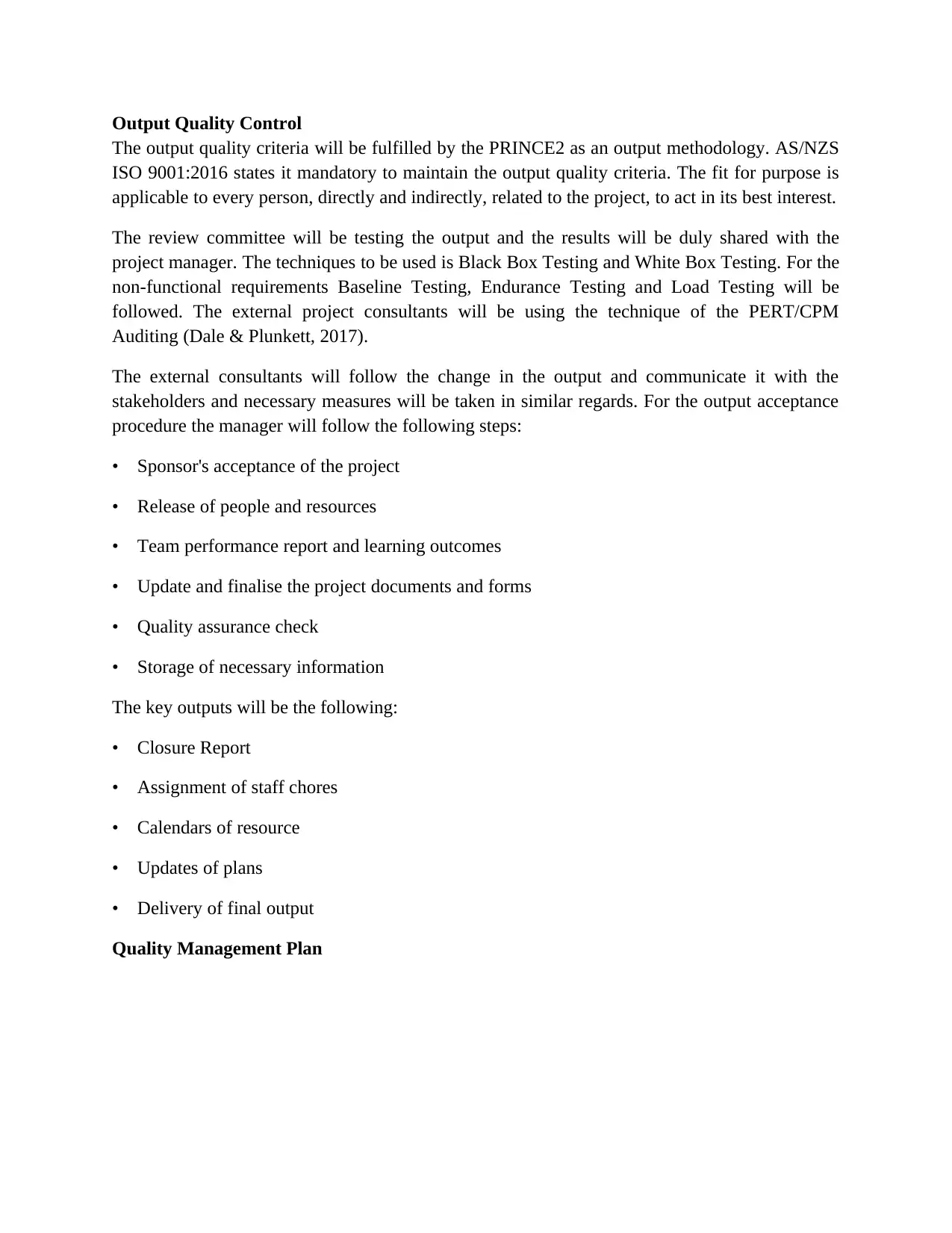
Output Quality Control
The output quality criteria will be fulfilled by the PRINCE2 as an output methodology. AS/NZS
ISO 9001:2016 states it mandatory to maintain the output quality criteria. The fit for purpose is
applicable to every person, directly and indirectly, related to the project, to act in its best interest.
The review committee will be testing the output and the results will be duly shared with the
project manager. The techniques to be used is Black Box Testing and White Box Testing. For the
non-functional requirements Baseline Testing, Endurance Testing and Load Testing will be
followed. The external project consultants will be using the technique of the PERT/CPM
Auditing (Dale & Plunkett, 2017).
The external consultants will follow the change in the output and communicate it with the
stakeholders and necessary measures will be taken in similar regards. For the output acceptance
procedure the manager will follow the following steps:
• Sponsor's acceptance of the project
• Release of people and resources
• Team performance report and learning outcomes
• Update and finalise the project documents and forms
• Quality assurance check
• Storage of necessary information
The key outputs will be the following:
• Closure Report
• Assignment of staff chores
• Calendars of resource
• Updates of plans
• Delivery of final output
Quality Management Plan
The output quality criteria will be fulfilled by the PRINCE2 as an output methodology. AS/NZS
ISO 9001:2016 states it mandatory to maintain the output quality criteria. The fit for purpose is
applicable to every person, directly and indirectly, related to the project, to act in its best interest.
The review committee will be testing the output and the results will be duly shared with the
project manager. The techniques to be used is Black Box Testing and White Box Testing. For the
non-functional requirements Baseline Testing, Endurance Testing and Load Testing will be
followed. The external project consultants will be using the technique of the PERT/CPM
Auditing (Dale & Plunkett, 2017).
The external consultants will follow the change in the output and communicate it with the
stakeholders and necessary measures will be taken in similar regards. For the output acceptance
procedure the manager will follow the following steps:
• Sponsor's acceptance of the project
• Release of people and resources
• Team performance report and learning outcomes
• Update and finalise the project documents and forms
• Quality assurance check
• Storage of necessary information
The key outputs will be the following:
• Closure Report
• Assignment of staff chores
• Calendars of resource
• Updates of plans
• Delivery of final output
Quality Management Plan
⊘ This is a preview!⊘
Do you want full access?
Subscribe today to unlock all pages.

Trusted by 1+ million students worldwide
1 out of 17
Related Documents
Your All-in-One AI-Powered Toolkit for Academic Success.
+13062052269
info@desklib.com
Available 24*7 on WhatsApp / Email
![[object Object]](/_next/static/media/star-bottom.7253800d.svg)
Unlock your academic potential
Copyright © 2020–2025 A2Z Services. All Rights Reserved. Developed and managed by ZUCOL.





